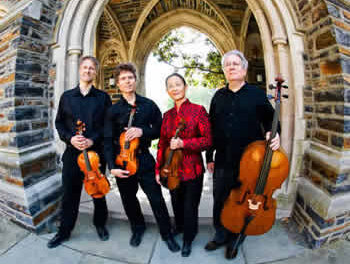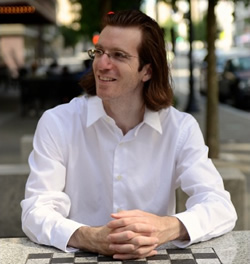The Turchin Center for the Visual Arts hosted the Summer Exhibition Celebration curated by Mary Anne Redding and Jennie Carslisle that included Dare Coulter‘s installation Celestial, the Art Department’s Faculty Biennial, Nicole Pietrantoni‘s exhibit Folded and Gathered, Lowell Hayes‘ Ukraine, A response to the Madness, and an artist talk and exhibition by Bart Vargas called Multitudes.
During his artist talk, Vargas said, “all materials have a perceived value, and an inherent value.” Those words rang in my ears as I viewed the rest of the Summer Exhibition Celebration. I appreciated that most of the work in the exhibitions included an element of a repurposed material because, according to Vargas, “we live in an era of limited resources and extraordinary consumption and waste.”
Celestial is a site-specific mural installation by Dare Coulter that explores themes of space and the cosmos. The exhibit is a series of figurative and abstract multimedia works that explore metaphor and creation. Coulter created this installation over the course of her three-week residency at Appalachian State University. With the assistance of five App State student interns, Coulter and her team painted the entire gallery in black and blue. Guests are asked to either take their shoes off or wear plastic booties because the work extends from the walls onto the floor.
The exhibit intends to be a fully immersive step into the cosmos, yet I did not get that impression. The gallery is lit with black lights and has dangling cardboard stars scattered throughout the gallery, but perhaps the exhibit would have had more impactful in a darker gallery that is not hit with direct sunlight. I have seen Coulter’s previous work and was excited to have one of her installations in my local art museum; however, I was underwhelmed by the exhibit and to me it felt rushed and unrefined.
The Art Department’s Faculty Biennial is a collaborative exhibition organized between the Turchin Center and the Smith Gallery to engage the community with ideas and creations from its local residents and art educators. The non-juried exhibition consists of work from 37 different artists ranging in all mediums. This Biennial is a great opportunity because it allows the students and the community the chance to see their educators work, as well as giving the educators an opportunity to showcase work that might be difficult to showcase elsewhere. I spoke with artist and professor Travis Donovan and he explained how exhibitions like these are awesome, because sometimes it can be difficult to exhibit work from previous years in other galleries. This is important, especially considering that most of the work in the faculty show was created between 2019 and 2022, during the global pandemic.
Many works in the Faculty Exhibition include found objects such as leaves with intricate stitching, a container full of laundry lint from the pandemic, a floating dandelion seed, a rotating communion tray, and many more. As a student who is working towards a BFA in studio art, it is inspiring and beneficial to see how some of my professors conceptualize and articulate their ideas.
Folded and Gathered is a collection of hanging books and bent steel by Nicole Pietrantoni that explores the representation of beauty in times of loss, and illustrates how photography’s role is to strengthen relationships with others and the diminishing environment through shared human memories. Her experimental book format challenges how printed matter can be used to enable and undercut human interactions. Much of her work is informed by her time spent in ecologically fragile landscapes, and this theme is reiterated by her choice of delicate Japanese kozo paper for the books, further demonstrating the fragility of human memory and recorded history.
Folded and Gathered is made up of multiple evenly hung creased booklets and steel. Pietrantoni typically works in paper and it was surprising to see steel mixed into the exhibit. If I had not read the label, I would have missed that the sculptures were steel and mistaken them for paper. I interpreted the steel as juxtaposing the weight of our struggling ecology against the fragile aspects that are represented in her paper booklets. The bright pink paint on the back of the steel reflected off the wall to backlight the sculptures, and the color also mimicked that of the pink wall leading into the gallery – I appreciated this cohesion.
Lowell Hayes is a well-known artist local to Boone whose work is typically associated with nature, specifically Hemlock trees and how their population is shrinking. Hayes usually advocates for the preservation of nature – however, with Ukraine, A response to the Madness, he is advocating for the preservation of people, a nation, and peace. Hayes was scheduled to have an exhibit at the Turchin before Russia attacked Ukraine, and afterwards he was so devastated that he felt incapacitated to create art in lieu of the worldwide tragedy. The subject matter of Hayes’ installation is a torn and burned Ukrainian flag that hangs over his traditional landscape scenery. The flag represents the people and the country to show support for what is being lost.
Multitudes by Bart Vargas is a twenty-year retrospective that consists of several sculptures and paintings built from salvaged materials. The title of the exhibition refers to the multitudes of waste that humans produce, and Vargas challenges the viewer to consider where it goes and where it could go. All the work in Vargas’ exhibition is made up of repurposed materials, and his sculptures echo familiar sights from human culture such as pills, bombs, maps, eggs, etc.; most of which are adorned with hundreds and thousands of computer keyboard keys. Large globes (literally) covered in bottles dangle from the ceiling like planets. Behind them on the wall are circular portal-like paintings that serve as a development of clarity and/or a window into something bigger than us. The red in the paintings represents the infrared light that Edwin Hubble used to prove that the universe is expanding, and Vargas uses the red to show a transition into clarity, while the contrasting blues mean a transition out of clarity.
During Vargas’ artist talk, he spoke about the harmful nature of plastic and the looming global waste problem. He explains how the value of an object is in its perception and how the global implication of plastic carries a heavy weight on our environment. Vargas’ medium of found objects continues to challenge the traditional definition of artistic medium. To him, there is no need to go out and buy materials because there are already so many resources for us to use and repurpose. Vargas hopes that his sculptures will serve as artifacts and evidence that represent the dawn of the Anthropocene.
Lots of the work in the collections contained or were built with recycled materials. The entire evening, I considered the amount of waste each work produced and how that could be repurposed. The collection of work made me ask questions like, “How much metal or wood had to be shaved away to create this?”, “Where are the rest of the keyboards?”, and “Does Celestial need plastic booties?”
The Summer Exhibition Celebration has one of the brightest collections of work I have seen at the Turchin Center. However, it ironically carried a heavy somber tone. Most of the work included repurposed materials that, in conjunction with Vargas’ artist talk, created a bleak experience that made me walk away considering the ways humans negatively interact and engage with the world and the items around them. So much of the subject matter is about global tragedy, the receding ecology, and the insurmountable amount of human waste, that I found it difficult to understand the “Celebration” of the event.
Celestial is up until August 27th, the Art Department’s Faculty Biennial is up until November 4th, Multitudes and Ukraine, A response to the Madness are showing until December 10th, and Folded and Gathered is up until February 4th.












